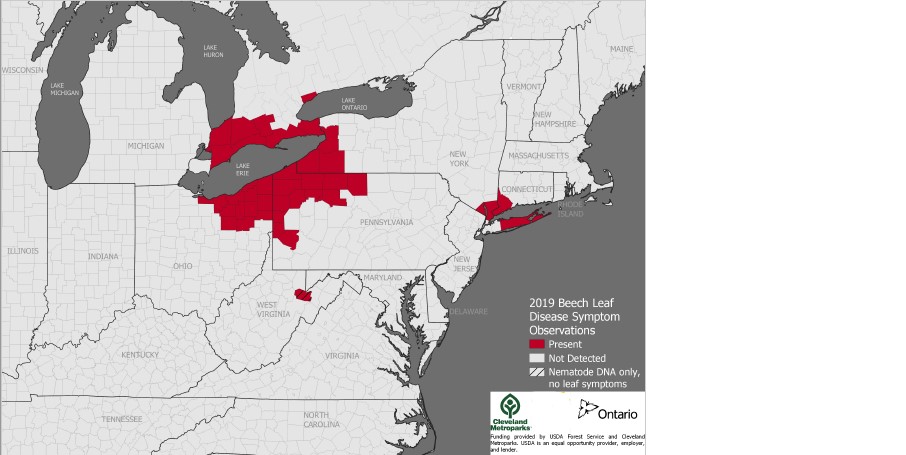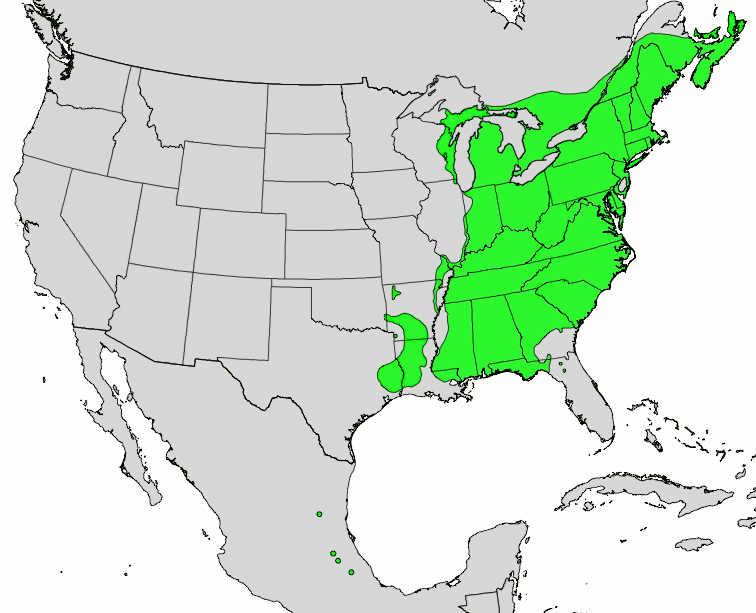Beech trees have leafed out – so now is the time to search for symptoms of beech leaf disease.
Since its first detection near Cleveland in 2012, BLD has now been detected in 40 counties in Ohio, New York, Pennsylvania, Connecticut, and Ontario. (see map)

I ask your help now because homeowners detected the outbreaks in Connecticut in 2019. (It is often homeowners or curious citizens who detect outbreaks of tree-killing pests.)
What to look for – symptoms:
- Dark bands between lateral veins of leaves. Banding is most apparent when viewing from below, looking upwards into the canopy. Banding is evident immediately upon leaf-out in the spring.
- Aborted bud development and reduced leaf production.
- Later stages result in heavily banded-darkened leaves that are thickened and leathery in texture, often with shriveled or curled edges.
All range of symptoms can be present on the same branch. Symptoms on individual leaves do not advance over the course of the summer. Severely affected leaves can drop off as summer progresses, sometimes as early as June. So the early season – now – is the best time to search.
Cleveland MetroParks has posted a pest alert (from last year), a report on symptom progression with good photos, and instructions for participating in the Beech Tree Health Survey. Survey apps are available as iOS: https://apps.apple.com/us/app/tree-health-survey/id1498515762 or Android: https://play.google.com/store/apps/details?id=com.KentState.TreeHealth&hl=en_US
Go to https://www.clevelandmetroparks.com/parks/education/publications and scroll down to the Beech Leaf Disease section (it is in large font so you won’t miss it).
Where to look? See the map of the range of American beech.

Range of American beech; source Wikimedia
In addition to checking American beech (Fagus grandifolia), also examine European beech (F. sylvatica), and Oriental beech (F. orientalis).
I encourage you to use one of the apps. However, if you are not but see something suspicious, send me a picture by using the “contact us” button. I will take a quick look, consult with experts, and – if they see what appear to be symptoms – they will tell me and I will tell you how to contact plant health authorities in your state or province.
Remember to include your email and phone number in your message to me – the “contact” form by itself does not provide sufficient information for me to respond to you.
Posted by Faith Campbell
We welcome comments that supplement or correct factual information, suggest new approaches, or promote thoughtful consideration. We post comments that disagree with us — but not those we judge to be not civil or inflammatory.
For a detailed discussion of the policies and practices that have allowed these pests to enter and spread – and that do not promote effective restoration strategies – review the Fading Forests report at http://treeimprovement.utk.edu/FadingForests.htm